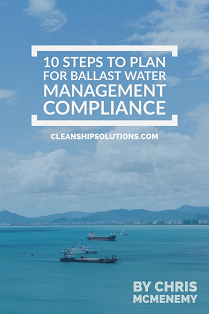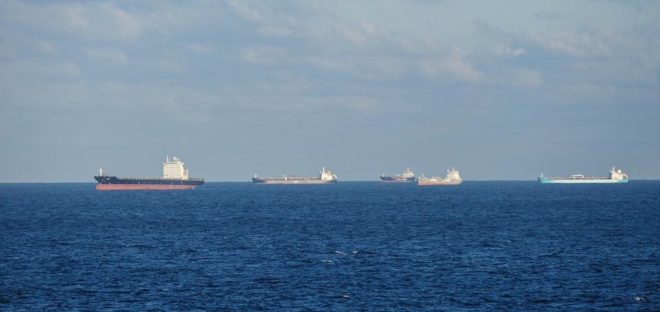10 Steps to Plan for Ballast Water Management Compliance
By Chris McMenemy – published on June 15, 2017

With the countdown to entry into force on, it is more important than ever that vessel owners and operators begin to plan for ballast water management compliance. With a myriad of legislation, requirements and seemingly ever-changing obligations, the benefits of planning early are clear.
Built on our 7 years experience helping over 40 owners and operators achieve compliance, we have developed a 10 step guide to planning for ballast water management compliance.
By following this guide, owners and operators can avoid some of the common pitfalls we typically observe during the compliance planning stage, and ensure that ballast water management compliance is achieved as seamlessly as possible.
1 – Compliance Obligations
The first step in planning for ballast water management compliance is to build a thorough understanding of the obligations of the various ballast water management legislation. Our guide to ballast water management legislation provides a thorough walkthrough of the various legislation and applicability, however, in summary, the legislation will likely require:
- That ballast water management procedures comply with the applicable legislation
- That an approved ballast water management plan be developed for each vessel, implemented, and followed, at all times, by the vessel’s crew
- That any ballast water discharges comply with the applicable discharge standards
- That vessel crew maintain accurate records of all ballast water operations in the ballast water record book
- That any installed ballast water treatment systems be operated in accordance with the manufacturers guidance and instructions
2 – Analyse Fleet Profile & Fleet-wide Compliance Dates
Before undertaking any planning activities on specific vessels, it is prudent to compile a detailed fleet compliance review for all vessels in the fleet. With different legislation having differing compliance dates, it is important to build an overview of the entire fleet, identifying the most pertinent vessels and shaping the fleet compliance timetable accordingly.
This step also provides vessel owners and operators with an opportunity to review the fleet profile from a scrapping / replacement perspective – identifying older vessels that owners may not be economically viable candidates for investing in retrofitting ballast water treatment systems.
Once the fleet timeline is understood, the following steps should be undertaken for each vessel in the fleet individually.

Achieving Ballast Water Management Compliance – Ensure Fleet is Analysed
3 – Existing Ballast System & Ballasting Procedures
A thorough review of the existing ballast system onboard, and the procedures currently followed by the vessel crew for all ballasting / de-ballasting operations is essential in planning for ballast water management compliance. It is crucially important to identify any potential physical alterations required to ensure compliance can be achieved, as well as any modifications to existing operational practices.
Physical changes can vary according to the layout and philosophy of individual ballast systems, however, can typically include:
- Upgrades and/or replacement of existing ballast pumps
- Re-configuring existing ballast pipework
- Addition of control valves / instrumentation to ensure legislative requirements met
- Re-configuring of control philosophy of existing ballast system
- Re-configuration of any multi-purpose tanks to be dedicated to intended purpose– such as ballast tanks used for temporary storage of black or grey water – such mixing shall no longer be permitted
Operational changes can typically include:
- Prevention of gravity ballasting / de-ballasting – which, due to most ballast water treatment systems requiring treatment during ballast and de-ballasting, may no longer be suitable
- Holding time of ballast water onboard – depending on the ballast water treatment technology utilised, it may be a requirement to refresh any ballast water held captive onboard more frequently
4 – Develop & Submit Ballast Water Management Plan (Exchange)
Prior to undertaking any further planning on the retrofit installation of a ballast water treatment system (if required and/or planned for), it is important to begin planning for compliance with the D-1 standard. As outlined in our recent article: “Implementing Ballast Water Management Plans”, the D-1 standard will apply to all vessels from entry into force.
Owners and operators should begin developing vessel specific ballast water management plans based on conducting ballast water exchange, and submit these to Class / Flag with sufficient time prior to entry into force.
Once approved, these plans should be implemented onboard, with all crew thereafter conducting ballast water operations in accordance with the ballast water management plan.
5 – Check Feasibility of Ballast Water Treatment Systems
Once the existing ballast system philosophy and operation is understood, and assuming the installation of a ballast water treatment system is the intended method of compliance, it is important to then undertake a feasibility study of the various ballast water treatment technologies and systems available.
No single technology, never mind specific system, is suitable for all vessels, and blindly selecting and installing a ballast water treatment system without determining its feasibility can result in non-suitable technologies or systems onboard, which may potentially lead to non-compliance.
Feasibility studies can take many forms, and may or may not include 3D laser scanning of the subject vessel first. Regardless, a feasibility study should be ship specific (or Class specific in the case of sister vessels), and should, as a minimum, identify and analyse the suitability of the treatment system against the following:
- Ballast pump & eductor performance
- Locations for ballast water treatment system onboard
- Complexity of integration of each potential ballast water treatment system
- Impact of ballast water treatment system on ballast rates & eductor performance
- Power balance of vessel and availability of spare power
- Suitable spare breakers on switchboard
- Trading locations & typical ballast water conditions (UV-T, Salinity, Temperature)
Feasibility studies should aim to analyse all of these aspects, comparing the various ballast water treatment system options, and conclude on, at least, the most suitable technology, if not the most suitable system(s).

Ballast Water Management Feasibility Studies Should Examine System Component Locations – Copyright Cleanship Solutions 2017
6 – Negotiate with Manufacturers
Assuming the feasibility study stage resulted in conclusion of the most suitable system(s) for the subject vessel, the next stage in the planning process is to engage the manufacturers and begin negotiating on price and delivery timescales. The planning of the retrofit installation phase is outlined in step 5 below; however, delivery timescales of the ballast water treatment system will have a big impact on this planning process, and must be fed directly in to the project management team.
At this stage it is important to engage manufacturers will sufficient notice, ahead of intended retrofit installation dates. Delivery times (ex-works) of up to six months are fairly common with ballast water treatment systems, hence it is crucial to undertake this step as soon as practical.
7 – Plan for Retrofit Installation
The retrofit installation of a ballast water treatment system requires careful consideration and planning. Depending on the vessel’s ultimate compliance date, and its trading patterns, the retrofit installation will likely be executed in one of, or a combination of, the following circumstances:
- During a scheduled drydocking
- Whilst vessel is alongside
- During vessel operation using riding squads
Regardless of the installation approach, a project manager (or project management team on larger projects) will be required to ensure the project runs smoothly. The project manager will handle all aspects of the retrofit design, class approval of same, procurement (beyond the treatment system itself there will be a significant procurement exercise required including fabrications, instrumentation, material, control integrations etc), delivery of all items to site and final installation. The commissioning is no easy task either, and the project manager will be required to coordinate the various parties involved – including the vessel crew, the ballast water treatment system manufacturer, control system manufacturer and Class Inspectors.